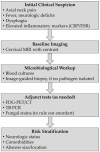Cervical Pyogenic Spondylitis: A Comprehensive Review of Diagnosis and Treatment Strategy
- PMID: 40429514
- PMCID: PMC12111958
- DOI: 10.3390/jcm14103519
Cervical Pyogenic Spondylitis: A Comprehensive Review of Diagnosis and Treatment Strategy
Abstract
Cervical pyogenic spondylitis (CPS) is a rare but serious spinal infection with a high risk of neurological compromise due to the cervical spine's narrow canal and proximity to critical neurovascular structures. Early diagnosis relies on a high index of suspicion supported by MRI, inflammatory markers, blood cultures, and tissue biopsy. Empirical intravenous antibiotics remain the cornerstone of initial treatment, followed by pathogen-specific therapy. Surgical intervention is indicated in cases of neurological deterioration, spinal instability, or failure of conservative management. Anterior approaches, including anterior cervical discectomy and fusion (ACDF) and anterior cervical corpectomy and fusion (ACCF), are widely used, with anterior plating providing biomechanical advantages in select cases. Posterior or combined anterior-posterior approaches are recommended in multilevel disease, deformity, or posterior element involvement. Graft selection-typically autograft or titanium/PEEK cages-must consider infection severity and biomechanical demands. Challenges in CPS management include optimal debridement extent, graft choice in infected environments, the standardization of antibiotic protocols, and the prevention of recurrence. This narrative review synthesizes the cervical-spine-specific literature on diagnosis, treatment strategies, surgical techniques, and postoperative care and proposes the following practical clinical guidance: (1) early MRI for timely diagnosis, (2) prompt surgical intervention in patients with neurological deficits or mechanical instability, and (3) individualized graft selection based on infection severity and bone quality.
Keywords: antibiotic therapy; cervical spine; diagnosis; interbody graft; pyogenic spondylitis; spinal instrumentation; surgical intervention.
Conflict of interest statement
The authors declare no conflict of interest.
Figures







Similar articles
-
Cervical alignment after single-level anterior cervical corpectomy and fusion using autologous bone graft without spinal instrumentation for cervical pyogenic spondylitis.Eur J Orthop Surg Traumatol. 2020 Apr;30(3):479-484. doi: 10.1007/s00590-019-02594-1. Epub 2019 Nov 9. Eur J Orthop Surg Traumatol. 2020. PMID: 31707454
-
Anterior cervical spine surgery for the treatment of subaxial cervical spondylodiscitis: a report of 30 consecutive patients.Neurosurg Focus. 2019 Jan 1;46(1):E6. doi: 10.3171/2018.10.FOCUS18464. Neurosurg Focus. 2019. PMID: 30611164
-
Biomechanical Comparison of Anterior Cervical Corpectomy Decompression and Fusion, Anterior Cervical Discectomy and Fusion, and Anterior Controllable Antedisplacement and Fusion in the Surgical Treatment of Multilevel Cervical Spondylotic Myelopathy: A Finite Element Analysis.Orthop Surg. 2024 Mar;16(3):687-699. doi: 10.1111/os.13994. Epub 2024 Feb 5. Orthop Surg. 2024. PMID: 38316415 Free PMC article.
-
Pediatric cervical kyphosis in the MRI era (1984-2008) with long-term follow up: literature review.Childs Nerv Syst. 2022 Feb;38(2):361-377. doi: 10.1007/s00381-021-05409-z. Epub 2021 Nov 22. Childs Nerv Syst. 2022. PMID: 34806157 Review.
-
Beneficial influence of titanium mesh cage on infection healing and spinal reconstruction in hematogenous septic spondylitis: a retrospective analysis of surgical outcome of twenty-five consecutive cases and review of literature.Spine (Phila Pa 1976). 2008 Oct 1;33(21):E759-67. doi: 10.1097/BRS.0b013e318187875e. Spine (Phila Pa 1976). 2008. PMID: 18827680 Review.
References
Publication types
LinkOut - more resources
Full Text Sources

